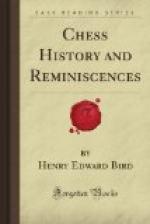The World, a London newspaper in its issue of the 28th May, 1783, makes the following remarks upon Philidor’s performance of playing two games simultaneously without sight of the board. It scarcely, however, comes up to our American cousin’s views of Morphy in 1858, just three-quarters of a century later. It says: “This brief article is the record of more than sport and fashion, it is a phenomenon in the history of man and so should be hoarded among the best samples of human memory, till memory shall be no more. The ability of fixing on the mind the entire plan of two chess tables without seeing either, with the multiplied vicissitudes of two and thirty pieces in possible employment on each table, is a wonder of such magnitude as could not be credible without repeated experience of the fact.”
Philidor himself notes also, being of opinion that an entire collection of the games he has played without looking over the chess board would not be of any service to amateurs, he will only publish a few parties which he has played against three players at once, subjoining the names of his respectable adversaries in order to prove and transmit to posterity a fact of which future ages might otherwise entertain some doubt.
During the years 1855-6 and 7, Louis Paulsen at Chicago, and other cities in the west of America, first accomplished the feat of playing ten games at chess simultaneously, without seeing the board or pieces, now familiarly called Blindfold Chess; and at Bristol, in 1861, and at Simpson’s Divan, London, in the same year, he repeated the performance, on the last occasion meeting twelve very powerful opponents.
The phenomenon Paul Morphy, from New Orleans, when twenty years of age only, conducted eight games blindfold at Birmingham, in August, 1858, losing one to Dr. Salmon of Dublin, drawing with Mr. Alderman Thomas Avery, and winning the remaining six. Morphy at Paris, in March, 1859, repeated the performance, and won all eight games; his play was superb, and all agree has never been surpassed, if equalled, and drew forth press notice even more gushing than that bestowed upon his predecessor Philidor.




